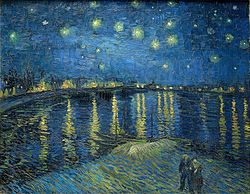Ursa Major
Ursa Major is a constellation in the northern part of the sky. Its name means Great Bearin Latin. It was named that because many different groups of people around the world have thought that its stars look a lot like a bear with a long tail. It is often used as a symbol for north.
 Click for larger image | |
| List of stars in Ursa Major | |
| Abbreviation: | UMa |
| Genitive: | Ursae Majoris |
| Symbology: | |
| Right ascension: | 10.67 h |
| Declination: | +55.38° |
| Area: | 1280 sq. deg. (3rd) |
| Main stars: | 7, 20 |
| Bayer/Flamsteed stars: | 93 |
| Stars known to have planets: | 20 |
| Bright stars: | 7 |
| Nearby stars: | 8 |
| Brightest star: | ε UMa (Alioth) (1.76m) |
| Nearest star: | Lalande 21185 ( ly) |
| Messier objects: | 7 |
| Meteor showers: | Alpha Ursa Majorids Leonids-Ursids |
| Bordering constellations: | Draco Camelopardalis Lynx Leo Minor Leo Coma Berenices Canes Venatici Boötes |
| Visible at latitudes between +90° and −30° Best visible at 21:00 (9 p.m.) during the month of April | |
| The Big Dipper or Plough. | |
According to Greek mythology, Ursa Major was once the beautiful maiden Callisto, whom the god Zeus had an affair with. In order to protect her and their son, Arcas, from his jealous wife Hera, Zeus turned Callisto and Arcas into bears. He then picked up the bears by their short, stubby tails and threw them into the sky.[1]
It can be seen in the northern hemisphere and part of the southern hemisphere. The constellation cannot be seen from the southern areas of Patagonia, South Africa, Australia, and all of New Zealand except the Northland region.
Deep-sky objects
Several bright galaxies are found in Ursa Major, including the pair Messier 81 (one of the brightest galaxies in the sky) and Messier 82 above the bear's head, and the Pinwheel galaxy (M101), a beautiful spiral galaxy northwest of the star η Ursae Majoris. Other well-known spiral galaxies are NGC 4102, NGC 4605, Messier 108 and Messier 109. The constellation has about 50 galaxies that can be seen with a small telescope. The Owl nebula, the brightest planetary nebula, can be found along the bottom of the bowl of the Big Dipper.
The Big Dipper
The seven stars in the northeast corner of Ursa Major form an called the Big Dipper (or the Plough in Great Britain). This group has been recognized by almost all groups of people who live or lived in places where it can be seen in the sky and it is one of the best-known star patterns. The Big Dipper is helpful in finding the north star because an imaginary line drawn through the two stars on the right side will point directly at the north star. These two stars are called The Pointers and they are very important on navigation by stars.
All of the stars in the Big Dipper except Dubhe and Alkaid are moving toward the same point in the sky through proper motion. This group of stars is known as the Ursa Major Moving Group.
Ursa Major Media
Ursa Major shown on a carved stone, c. 1700, Crail, Fife
Starry Night Over the Rhone by Vincent van Gogh (1888)
References
- ↑ "Ursa Major in Greek Mythology| the myth of Zeus and Callisto". 20 March 2011.








